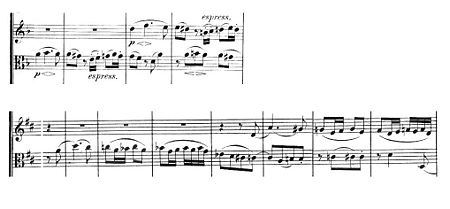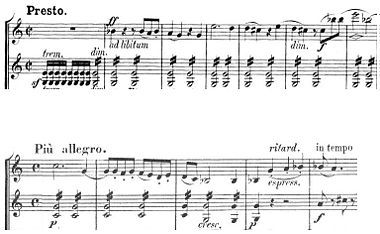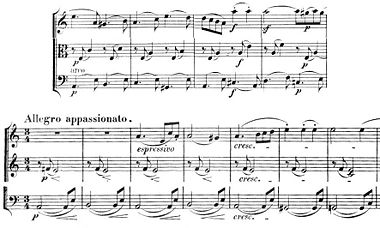.gif)
String Quartet No. 2 (Mendelssohn)
Encyclopedia
The String Quartet No. 2 in A minor, Op
. 13, was composed by Felix Mendelssohn
in 1827. Written when he was 18 years old, it was, despite its official number, Mendelssohn's first string quartet. The quartet draws much of its inspiration from Beethoven's quartets.
:
A typical performance lasts about 30 minutes.
 Though Mendelssohn was still a teenager when he wrote this quartet, he was already an experienced composer of chamber music. He had already written the string quintet opus 18, the octet for strings opus 20, and two piano quartets. He had a few months before produced his opera Die Hochzeit von Camacho, which was not a success. (His quartet Opus 12, though it bears an earlier opus number, was actually written two years later.)
Though Mendelssohn was still a teenager when he wrote this quartet, he was already an experienced composer of chamber music. He had already written the string quintet opus 18, the octet for strings opus 20, and two piano quartets. He had a few months before produced his opera Die Hochzeit von Camacho, which was not a success. (His quartet Opus 12, though it bears an earlier opus number, was actually written two years later.)
Mendelssohn wrote the quartet two years after Ludwig van Beethoven
published his last quartets, and months after his death. Beethoven's late quartets received a lukewarm reception at best, and many — including Mendelssohn's own father — agreed with composer Louis Spohr
that they were an "indecipherable, uncorrected horror". Mendelssohn, however, was fascinated by them. He studied the scores, and included many quotes from Beethoven's quartets in opus 13.
As a unifying motif, Mendelssohn included a quote from the song "Ist es wahr?" ('Is it true?', op. 9 no. 1), which he composed a few months earlier, for baritone and piano, based on a poem by Johann Gustav Droyson: "Is it true that you are always waiting for me in the arbored walk?" Mendelssohn includes the title of the song in the score of the quartet, recalling the title Beethoven wrote on the last movement of his Op. 135
string quartet "Muss es sein?" (Must it be?). But, unlike the introspective, existential quality of Beethoven's quartet, Mendelssohn's work is richly romantic. "...This quartet, relying heavily on compositional techniques of late Beethoven, links Classical form to Romantic expression," writes analyst Lucy Miller.
 The three-note motif from "Ist es wahr?", presented in an opening Adagio in the key of A Major, establishes the cyclic form of the quartet; the motif appears in all four of the movements, and concludes the quartet. After the Adagio introduction, the quartet breaks into a tumultuous Allegro Vivace in Sonata form
The three-note motif from "Ist es wahr?", presented in an opening Adagio in the key of A Major, establishes the cyclic form of the quartet; the motif appears in all four of the movements, and concludes the quartet. After the Adagio introduction, the quartet breaks into a tumultuous Allegro Vivace in Sonata form
in A minor. So the quartet, which is mostly in minor keys, and is primarily minor in character, opens and closes in a major key — a rather daring departure from standard quartet-writing practice of the time. The opening closely resembles Beethoven's Op. 132
quartet: that quartet, also, has an opening adagio, then a first theme built of running sixteenth notes and a lyrical passage, which is close to an inversion of Mendelssohn's theme.
The Adagio movement has a middle slow, fugal section which is modelled after the fugal middle section of the slow movement of Beethoven's Op. 95
. The subjects of both fugues are sinuous melodies that slide down chromatically, moving from viola to second violin and then to the other voices. Like the Beethoven model, the fugue goes through a series of increasingly complex variations with cross-rhythms in the different instruments.
The Intermezzo movement opens with a light, gossamer theme which is Mendelssohn's signature style. The lilting theme in the first violin, with pizzicato accompaniment in the other instruments, recalls the overture to the incidental music to A Midsummer Night's Dream (op. 61) and scherzo movements from many of Mendelssohn's chamber works.


 The final movement of Beethoven's Op. 132
The final movement of Beethoven's Op. 132
quartet is a prototype for Mendelssohn's last movement: it begins with a cadenza interlude in the first violin, leading into a fast, melodic movement with a driving bass line in the cello which is a close copy of the cello part of Op. 132.
Opus number
An Opus number , pl. opera and opuses, abbreviated, sing. Op. and pl. Opp. refers to a number generally assigned by composers to an individual composition or set of compositions on publication, to help identify their works...
. 13, was composed by Felix Mendelssohn
Felix Mendelssohn
Jakob Ludwig Felix Mendelssohn Barthóldy , use the form 'Mendelssohn' and not 'Mendelssohn Bartholdy'. The Grove Dictionary of Music and Musicians gives ' Felix Mendelssohn' as the entry, with 'Mendelssohn' used in the body text...
in 1827. Written when he was 18 years old, it was, despite its official number, Mendelssohn's first string quartet. The quartet draws much of its inspiration from Beethoven's quartets.
Movements
This work has four movementsMovement (music)
A movement is a self-contained part of a musical composition or musical form. While individual or selected movements from a composition are sometimes performed separately, a performance of the complete work requires all the movements to be performed in succession...
:
- Adagio – Allegro vivace
- Adagio non lento
- IntermezzoIntermezzoIn music, an intermezzo , in the most general sense, is a composition which fits between other musical or dramatic entities, such as acts of a play or movements of a larger musical work...
: Allegretto con moto – Allegro di molto - Presto – Adagio non lento
A typical performance lasts about 30 minutes.
Composition

Mendelssohn wrote the quartet two years after Ludwig van Beethoven
Ludwig van Beethoven
Ludwig van Beethoven was a German composer and pianist. A crucial figure in the transition between the Classical and Romantic eras in Western art music, he remains one of the most famous and influential composers of all time.Born in Bonn, then the capital of the Electorate of Cologne and part of...
published his last quartets, and months after his death. Beethoven's late quartets received a lukewarm reception at best, and many — including Mendelssohn's own father — agreed with composer Louis Spohr
Louis Spohr
Louis Spohr was a German composer, violinist and conductor. Born Ludewig Spohr, he is usually known by the French form of his name. Described by Dorothy Mayer as "The Forgotten Master", Spohr was once as famous as Beethoven. As a violinist, his virtuoso playing was admired by Queen Victoria...
that they were an "indecipherable, uncorrected horror". Mendelssohn, however, was fascinated by them. He studied the scores, and included many quotes from Beethoven's quartets in opus 13.
As a unifying motif, Mendelssohn included a quote from the song "Ist es wahr?" ('Is it true?', op. 9 no. 1), which he composed a few months earlier, for baritone and piano, based on a poem by Johann Gustav Droyson: "Is it true that you are always waiting for me in the arbored walk?" Mendelssohn includes the title of the song in the score of the quartet, recalling the title Beethoven wrote on the last movement of his Op. 135
String Quartet No. 16 (Beethoven)
The String Quartet No. 16 in F major, op. 135, by Ludwig van Beethoven was written in October 1826 and was the last substantial work he finished. Only the last movement of the Quartet op. 130, written as a replacement for the Große Fuge, was written later. It was premiered by the Schuppanzigh...
string quartet "Muss es sein?" (Must it be?). But, unlike the introspective, existential quality of Beethoven's quartet, Mendelssohn's work is richly romantic. "...This quartet, relying heavily on compositional techniques of late Beethoven, links Classical form to Romantic expression," writes analyst Lucy Miller.
Analysis

Sonata form
Sonata form is a large-scale musical structure used widely since the middle of the 18th century . While it is typically used in the first movement of multi-movement pieces, it is sometimes used in subsequent movements as well—particularly the final movement...
in A minor. So the quartet, which is mostly in minor keys, and is primarily minor in character, opens and closes in a major key — a rather daring departure from standard quartet-writing practice of the time. The opening closely resembles Beethoven's Op. 132
String Quartet No. 15 (Beethoven)
The Quartet in A minor, Op. 132, by Ludwig van Beethoven, was written in 1825, given its public premiere on November 6 of that year by the Schuppanzigh Quartet and was dedicated to Count Nicolai Galitzin, as were Opp. 127 and 130...
quartet: that quartet, also, has an opening adagio, then a first theme built of running sixteenth notes and a lyrical passage, which is close to an inversion of Mendelssohn's theme.
The Adagio movement has a middle slow, fugal section which is modelled after the fugal middle section of the slow movement of Beethoven's Op. 95
String Quartet No. 11 (Beethoven)
Ludwig van Beethoven's opus 95, his String Quartet No. 11 in F minor, is his last before his exalted late string quartets. It is commonly referred to as the "Serioso," stemming from his title "Quartett[o] Serioso" at the beginning and the tempo designation for the third movement.It is one of the...
. The subjects of both fugues are sinuous melodies that slide down chromatically, moving from viola to second violin and then to the other voices. Like the Beethoven model, the fugue goes through a series of increasingly complex variations with cross-rhythms in the different instruments.
The Intermezzo movement opens with a light, gossamer theme which is Mendelssohn's signature style. The lilting theme in the first violin, with pizzicato accompaniment in the other instruments, recalls the overture to the incidental music to A Midsummer Night's Dream (op. 61) and scherzo movements from many of Mendelssohn's chamber works.



String Quartet No. 15 (Beethoven)
The Quartet in A minor, Op. 132, by Ludwig van Beethoven, was written in 1825, given its public premiere on November 6 of that year by the Schuppanzigh Quartet and was dedicated to Count Nicolai Galitzin, as were Opp. 127 and 130...
quartet is a prototype for Mendelssohn's last movement: it begins with a cadenza interlude in the first violin, leading into a fast, melodic movement with a driving bass line in the cello which is a close copy of the cello part of Op. 132.
Media
External links
- Lecture and performance on this quartet by Roger ParkerRoger ParkerRoger Parker is an English musicologist, and is currently Thurston Dart Professor of Music at King's College London....
and the Badke quartetBadke quartetThe Badke Quartet is an English string quartet. Founded in 2002 at London's Royal Academy of Music, it won 1st prize and audience prize in the 5th Melbourne International Chamber Music Competition....
, given at Gresham CollegeGresham CollegeGresham College is an institution of higher learning located at Barnard's Inn Hall off Holborn in central London, England. It was founded in 1597 under the will of Sir Thomas Gresham and today it hosts over 140 free public lectures every year within the City of London.-History:Sir Thomas Gresham,...
, 26 June 2008

